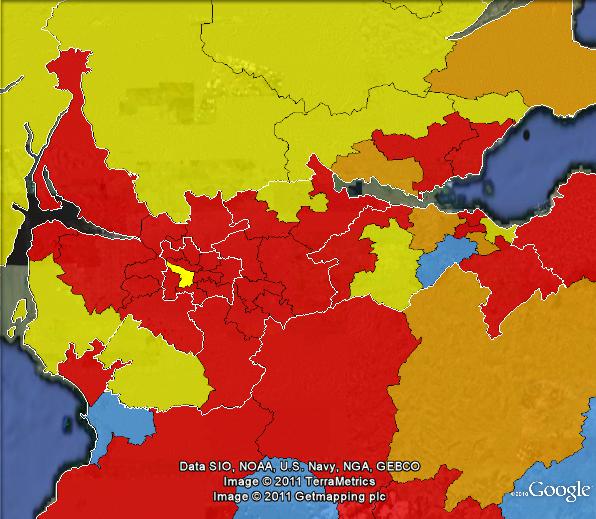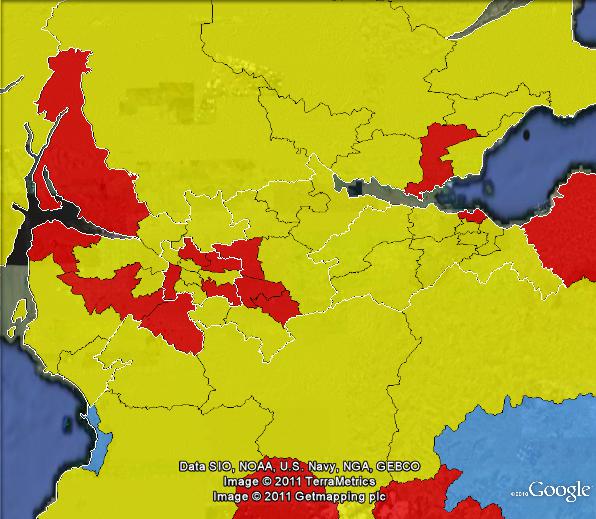The Scottish Parliament election produced a quite dramatic result, with the incumbent SNP minority government winning a comfortable majority, despite Scotland’s proportional voting system.
Scotland’s Parliament consists of 73 single-member constituencies, and 56 members elected on regional lists on a top-up basis.
Labour formed governments after the 1999 and 2003 elections in a relationship with the Liberal Democrats, but Labour never won a majority of seats.
In 2007, Labour won 37 constituency seats compared to only 21 for the opposition Scottish Nationalists, but the top-up seats went overwhelmingly to the SNP, giving them 47 seats overall, one more than Labour’s 46.
The SNP has governed as a minority in Scotland, and polling throughout most of the campaign had the SNP and Labour polling neck-and-neck, and suggested that Labour had a chance of returning to government.
The results, however, have been decisive for the SNP. The SNP won 53 of 73 constituency seats, compared to 15 for Labour, 3 for Conservative and two for the Liberal Democrats.
The SNP won a clean sweep of seats in the Highlands and the North East of Scotland, as well as nearly all seats in Mid Scotland and Fife. At the 2007 election the SNP won only one seat each in Edinburgh and Glasgow, and only four others in the heavily-populated region of Central and Southern Scotland.
The Conservatives lost one seat compared to 2007, but had gained two extra seats in the redistribution, so on the new boundaries it was a net loss of three. The Liberal Democrats were devastated. The party previously held 11 seats, including two in Edinburgh and a number of seats in the north of Scotland. This time around the party only held onto the constituencies of Orkney and Shetland.


Despite their very large number of constituency wins, the SNP still managed to benefit from top-up seats, winning seats in seven of eight regions.
Overall, the SNP won 16 list seats, down from 26 in 2007. This reduction was well and truly compensated for by 32 extra constituency seats. Remarkably, the SNP won all 10 constituency seats in the North East, but still qualified for an eleventh seat on the regional list.
Labour won 22 list seats, up 13 from 2007. This made up for many of the party’s 22 losses in constituencies.
Despite losing nine of their eleven constituency seats, the Liberal Democrats still went backwards on the regional lists, losing two of their five seats. Overall they only hold seats in four regions, and none in the Lothian, Central Scotland, Glasgow and West Scotland regions running through the middle of Scotland.
The Conservatives went slightly backwards, losing one constituency seat and one regional seat.
The Greens looked like benefiting from the collapse of the Liberal Democrat vote, but largely stood still with 4.4%. They retained their two seat in Lothian and Glasgow, but didn’t win any extra.
Overall, this gives the SNP 69 seats out of 129, a solid majority in a Parliament thought unlikely to ever produce a single-party majority. The government has set modest goals over the last four years, with a small minority government relying on the Conservatives and Greens to pass their budget. A much larger government is expected to have much bigger goals. In particular, it is expected that the SNP will move towards holding a referendum on Scottish independence later in their term.
Looking at the election figures, the SNP’s victory did not come from any collapse in vote for Labour. Labour’s vote went down 0.5% in the constituency vote and 2.9% in the list vote.
The SNP vote went up 12.5% in the constituency vote and 13% in the list vote. The largest portion of this came from the Liberal Democrats, who dropped 8.2% in the constituency vote and 6.1% in the list vote.
As is a consistent trend across other elections held on Thursday, it appears the Liberal Democrats have been severely punished by their voters for their role in government, while the Conservatives have suffered a slight backlash.
Overall, the result is a negative one for Labour. While they have benefited in England and Wales, the SNP has proven to be an effective alternative to the major parties that has also been very effective at being an opposition to the Coalition government in Westminster. Scotland will continue to be a thorn in Labour’s side over the next few years, now with a powerful and confident Nationalist majority government demonstrating an alternative to the major parties in Westminster.



I bet he LibDems on most of the Councils in Scotland are relieved that they did not face election today (their election is next year because it was decided after the 2007 election to no longer hold them concurrently) but they would probably prefer to have had the local elections last year so as to be before the coalition and cuts.
Comments are closed.